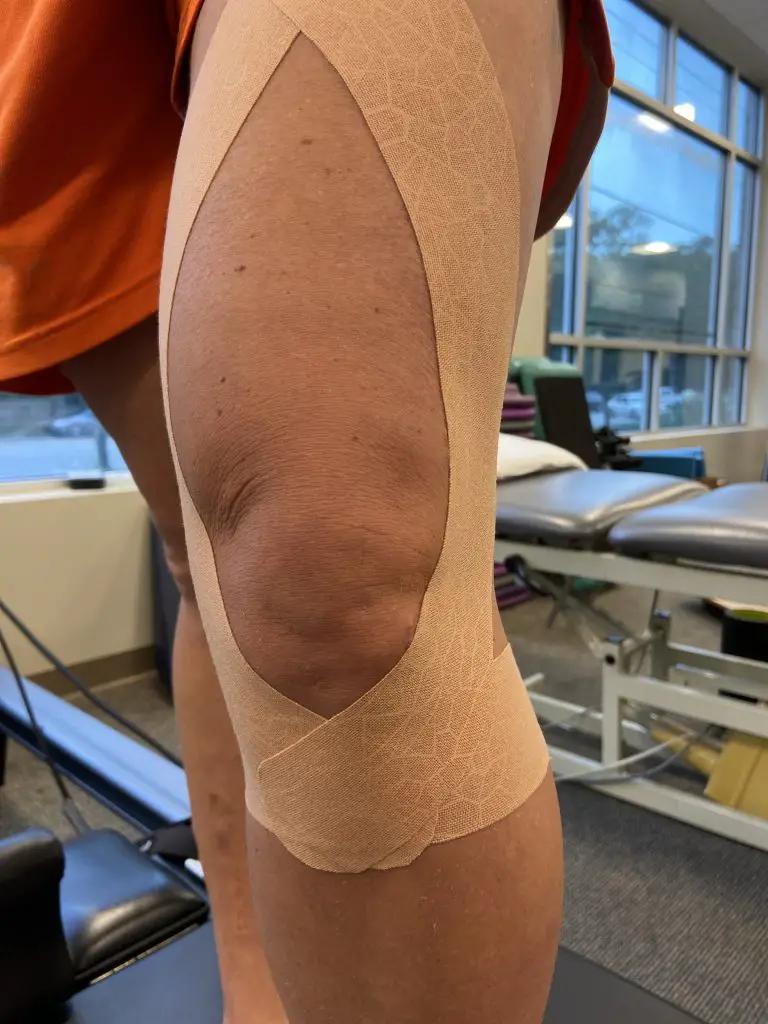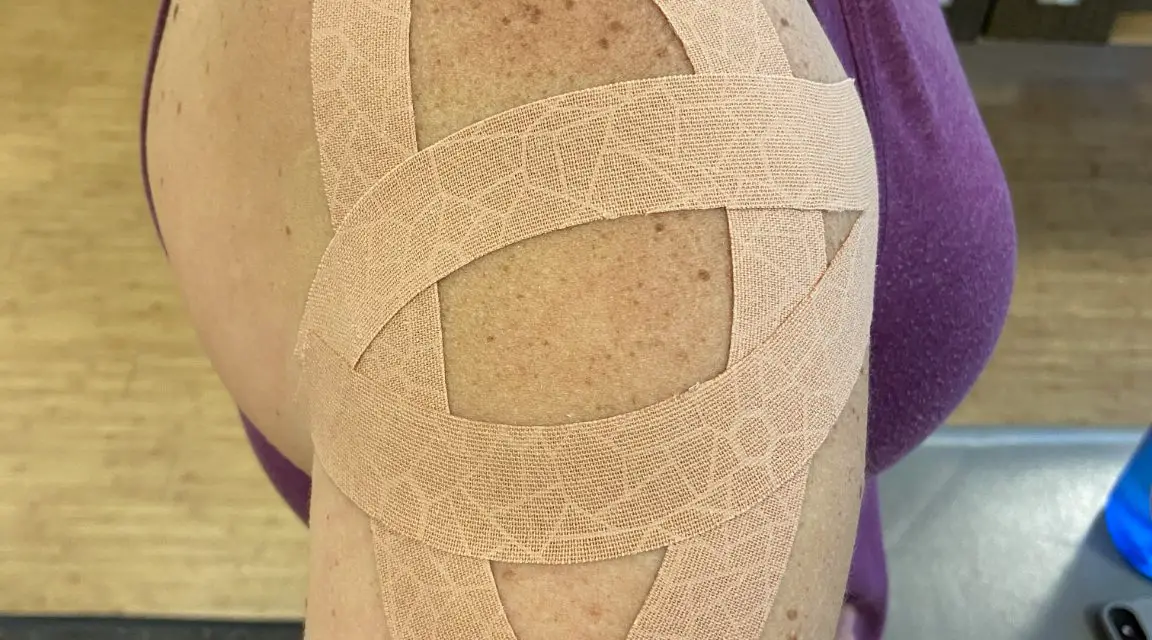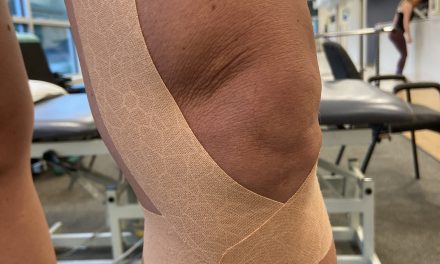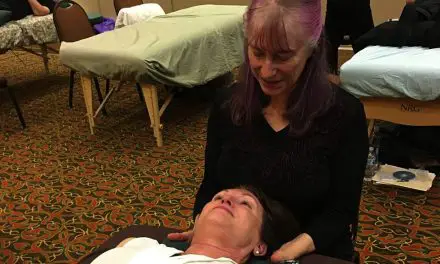KT Tape is one of the many brands of Kinesio Tape that has become wildly popular over the past few years. This class of tape was invented about 50 years ago by Dr. Kenzo Kase, a Japanese chiropractor who wanted to mimic a practitioner’s hands while the patient is away from the clinic.
The tape markets itself as an elastic sports and fitness tape thanks to a few features. It has a unilateral elasticity which allows it to get longer without narrowing. The PRO formula also touts a more breathable fabric, which makes this tape more comfortable and longer lasting.
KT Tape claims that when applied correctly, the tape can lift the skin so that the underlying tissues are under less pressure. Creating this space should improve the movement of lymphatic fluid, which is critical for removing cellular wastes from the body.
Decreasing the pressure on tissues may also alleviate pain or discomfort. KT Tape also suggests that wearing their product may support working muscles to avoid overuse. This is a pretty standard claim for most brands of KT Tape.
It comes in a variety of colors so you can just as easily make a fashion statement as you can match your skin tone. Most KT Tape rolls are made of pre-cut strips (uncut is available too) which makes it super easy to follow their instructional videos.
Rather than guessing how many inches it is from the middle of the upper arm to the top of the shoulder, a ready-to-use 6-inch strip comes right off the roll for you. They also have a few unique forms:
- extra wide tape
- a ready-made X-shaped tape that can go right over the painful spot
The tape typically stretches up to 100% of its resting length and is waterproof. Similar to its competitors, standard KT Tape is meant to be worn for three to five days and the PRO version can last up to a week.
All of the brands will generally stay in place through humidity, pools, lakes, oceans, sweat, and showers! KT Tape is the only tape that has reflective elements for enhanced safety if the wearer is working out at dusk or in darkness.
KT Tape and athletic tape share some similarities, but these terms shouldn’t be used interchangeably.
- Athletic tape generally has a supportive role as it strives to prevent or reduce the severity of injuries. It has minimal stretch and is made to be worn for a short time only — usually the length of a practice or competition.
- Athletic tape is generally not waterproof (although waterproof options are out there) and an underwrap (or pre-wrap) is almost always used to protect the skin from both the adhesive and any friction created between the skin and the tape that could lead to blisters.
Author’s note: “Kinesio Tape” refers to the brand while “kinesio tape” refers to the type (or class) of tape. This can be super confusing but the only thing that seems to make sense is that when it is referring to the brand, the K and the T are capitalized. When referring to the type of taping, the k and t are lower case. This is consistent in the research studies. “KT Tape¨ is a brand of kinesio tape.
How do you apply KT Tape to the shoulder?
There are several different ways to tape the shoulder with KT Tape. If you have a specific diagnosis, there is likely a taping technique to match. The steps outlined below describe the method that is widely used for general shoulder pain.
- Prepare the skin by wiping it clean of any excess lotions or oils.
- Cut two strips of tape that are approximately 6 inches long or use two pre-cut strips from the roll.
- Round the edges of the tape to decrease the likelihood of peeling (added bonus with pre-cut strips- this is done for you!)
- Pull the tape and paper backing apart about 2 inches from one end with enough tension to tear the paper. This creates a tail that is used to fix the tape to the skin so it is easier to work with — the backing of the tape should come off similarly to how you would apply a Band-Aid. You will repeat this step with the second piece of tape when you are ready to work with it.
- Locate the point on the upper arm where the “cap” of your shoulder comes to a point. This is typically 3 or 4 inches from the top of the shoulder in the middle of the upper arm. If you’re familiar with anatomy, this is where the three heads of the deltoid muscle come together.
- Secure the 2-inch tail of one of the pieces of tape to the point you just located where your shoulder “cap” comes together.
- Instruct the patient to raise their arm to shoulder height and reach across their body to create a stretch to the back of the shoulder.
- Apply the tape along the outline of the deltoid muscles (the “cap”) curving the last two inches back to the top of the shoulder.
- Fixate the second strip next to the first in the direction of the front side of the body.
- Direct the patient to reach their arm behind their back as if they were tucking a shirt in.
- Smooth the tape down along the front of the shoulder being sure to curve back to the top with the last 2 inches.
- Rub along the length of the tape to ensure good adhesion.
This taping technique can also be completed with a single “Y” strip.
If a “Y” is used, the single tail is centered over the point where the shoulder cap comes together and then each of the arms of the “Y” follows the path described above until they meet at the top of the shoulder.
In the end, the two tape jobs look nearly identical with the width of the tape strips being the only difference.
Does it matter how you tape the shoulder?
There are plenty of instructional videos on YouTube that teach a ton of techniques for taping the shoulder. In these videos, the position of the patient as well as the amount of tension, direction of pull, and location of the tape strips is made to be critically important.
In reality, it probably doesn’t matter all that much. If it works, it likely works because there is SOMETHING touching the skin, not because of precise location or tension. Also consider:
- There’s no actual research (yet) comparing taping methodologies, but we can infer that method likely doesn’t matter when we look at the studies and their findings.
- Several studies have found that Kinesio Tape on the shoulder is no better than other conservative treatments. Within the studies, each group of researchers used their preferred taping technique.
- The lack of any real support for shoulder tape despite several research groups using several different techniques suggests that how you apply the tape probably doesn’t matter.

Most taping methods are used to unload the patellar tendon and also give proprioception to the tissues around the knee. Photo: Penny Goldberg
In a study that compared taping techniques for the knee, it was discovered that when taped, the participants had less knee pain while climbing stairs. In the absence of any other observable findings, it’s suggested that the effectiveness of the tape may lie in its ability to stimulate the receptors in the skin that sense touch which, in turn, may hinder the brain’s ability to sense pain. This may hold true for all taping techniques on all body parts.
A 2023 study on patients with Ehlers-Danlos Syndrome compared two different taping techniques. Researchers found that patients had decreased pain and improved function regardless of which taping technique was used. The results of this study may not be generalizable to those without hypermobile Ehlers-Danlos but it does offer a low-cost intervention that can provide a path to reduced pain and increased function for these patients.
Thus, the lack of any real support for shoulder tape suggests that how you apply the tape probably doesn’t matter.
Does KT Tape work for shoulder pain?
Overall, the support for KT Tape at the shoulder is lacking. While most studies used Kinesio Tape, it may be applicable to KT Tape, too.
Systematic reviews and meta-analyses by Celik and colleagues, Ghozy et al., and Parreira et al. all found Kinesio Tape at the shoulder to be no more effective than any other treatment; the studies combined in these papers examined more than 1,500 participants. Parreira’s study even looked beyond the shoulder and found taping to be mostly ineffective no matter where it is on the body.
On the other hand, there is some weak support for Kinesio Tape at the shoulder. A 2008 study examined the use of therapeutic Kinesio Tape on shoulder pain, disability, and range of motion in participants with diagnosed rotator cuff tendinitis or impingement. They were taped for two consecutive three-day intervals. Pain, disability, and active range of motion were checked at multiple time points while the tape was worn and it was discovered that the application of tape produced immediate improvements in pain-free shoulder motion.
Although pain and disability were unchanged, this does suggest that tape may be clinically useful to allow those with painful shoulders to better tolerate larger ranges of motion during rehabilitation.
Salamh and colleagues investigated the efficacy of kinesio taping with conservative treatment in those with shoulder pain via systematic review and meta-analysis. Studies were included if they used Kinesio Tape to address known shoulder pathology in combination with conservative treatment.
The addition of tape in these conditions revealed improvements in disability and range motion. Taping did not produce an effect on pain. They concluded that applying Kinesio Tape decreased disability and improved range of motion beyond conservative treatment alone.
Research on Kinesio taping — whether it’s positive or negative — is generally rated low to very-low quality using the GRADE framework, which is a tool that considers elements of research including risk of bias, imprecision, inconsistency, indirectness, and publication bias. Basically, the GRADE tool determines whether or not the results of a study are worthy of being used to make sweeping recommendations.
It’s easy to see how problems with the research can lead to conclusions that might not be exactly as they seem.
Studies that call for multiple trials to be performed in a single day or using tape on patients with different conditions related to the same body region can create high risks of bias.
In the shoulder alone, pain could be coming from a rotator cuff tear, tendonitis, bursitis, impingement, labral tearing, or dislocation/subluxation. If the population of patients who are taped all get the same method of tape while having a variety of diagnoses, there’s no true information gleaned about the effectiveness of the tape for any specific condition.
Should you use KT Tape and other tapes?
There seems to be less support for kinesio tape for the shoulder than at other body regions. That said, it stands to reason that if the effect of tape on other body parts is predominantly related to the mere application of the tape, this should produce an effect at the shoulder as well.
Clinically, in the shoulder, just as in the knee, low back, foot and ankle, and wrist, I have seen it work…and I’ve seen it not work. I don’t find Kinesio taping for the shoulder to be supportive, but it can be useful for providing tactile input—at least immediately after application—regarding proper scapular position or posture. This can be helpful in patients who have difficulty feeling scapular movement.
In this case, the kinesio tape is doing precisely what Dr. Kase intended as it acts in place of the therapist’s hands to direct the patient into a better body position.
Generally, I’m not a proponent of using taping across the board. There’s no intervention that’s right for everyone (except exercise!). However, there’s a time and place for everything.
If taping helps your patient perform better during practice or competition, use it.
If it decreases your patient’s pain and affords them improved function, use it.
If you have tried all other conservative treatment options and are not getting the desired results, try it. There really is nothing to lose other than a few bucks.

Penny Goldberg, DPT, ATC
Penny Goldberg, DPT, ATC earned her doctorate in Physical Therapy from the University of Saint Augustine and completed a credentialed sports residency at the University of Florida. She is a Board Certified Clinical Specialist in Sports Physical Therapy.
Penny holds a B.S. in Kinesiology and a M.A. in Physical Education from San Diego State University. She has served as an Athletic Trainer at USD, CSUN, and Butler University.
She has presented on Kinesiophobia and differential diagnosis in complicated cases. Penny has published on returning to sports after ACL reconstruction and fear of movement and re-injury.
Outside of the clinic, Penny enjoys traveling, good cooking with great wine, concerts, working out and playing with her dogs.






